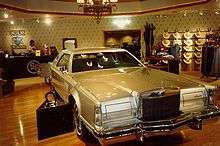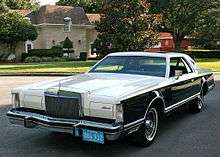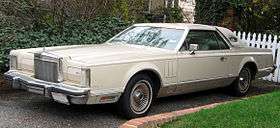Lincoln Continental Mark V
| Lincoln Continental Mark V | |
|---|---|
.jpg) | |
| Overview | |
| Manufacturer | Lincoln (Ford) |
| Production | 1977–1979 |
| Assembly | Wixom Assembly, Wixom, Michigan, USA |
| Body and chassis | |
| Class | Personal luxury car |
| Body style | 2-door coupe |
| Layout | FR layout |
| Powertrain | |
| Engine |
402 cu in (6.6 L) 400 Cleveland V8 460 cu in (7.5 L) 385/Lima V8 |
| Transmission | 3-speed C6 automatic |
| Dimensions | |
| Wheelbase | 120.5 in (3,061 mm)[1] |
| Length | 230.3 in (5,850 mm)[2] |
| Width | 79.7 in (2,024 mm)[2] |
| Height | 52.9 in (1,344 mm)[2] |
| Curb weight | 4,762–4,960 lb (2,160–2,250 kg)[2][3] |
| Chronology | |
| Predecessor | Lincoln Continental Mark IV |
| Successor | Lincoln Continental Mark VI |
The Lincoln Continental Mark V is a personal luxury coupe that was sold by Lincoln from the 1977 to the 1979 model years. Derived from the same chassis of its Mark IV predecessor, the Mark V was the largest member of the Lincoln Mark series ever produced. With an average of 75,000 units sold in each year available, the Mark V is also the best-selling version of the entire Mark series.
Overview

For the 1977 model year, after a five year production run, the Continental Mark IV was replaced by the updated Continental Mark V. In a cost-cutting move, Lincoln chose to re-use the same chassis and underpinnings (also shared with the 1972–1976 Ford Thunderbird).
Using a cancelled Mark IV styling proposal as a starting point,[4] Lincoln-Mercury designers replaced much of the rounded, flared detailing of the Mark IV with sharp-edged "bladed" fenders; the theme carried over into the greenhouse with a squared-off roofline. Styling cues unique to the Lincoln division (concealed headlights, oval opera windows and classic revival radiator grille) and the Continental Mark series (simulated trunklid "spare tire hump") were retained. To aid engine cooling, the Mark V gained functional fender louvers.
In a sign of the changes to come in the automobile industry, the Mark V made steps towards improving the fuel economy of luxury cars. While physically larger than its Mark IV predecessor, careful weight reduction measures trimmed 400 pounds from its curb weight. To further improve fuel economy, the 460 V8 was no longer standard equipment; the standard engine was the 400 Cleveland shared with the Ford Thunderbird and the full-size Ford and Mercury car lines.
Year-by-year changes
- 1977: Mark V introduced. Although technically an option, all Mark Vs are built with a padded rear vinyl landau half-roof unless custom-deleted by buyer.[5]
- 1978: Larger radiator added. 400 engine detuned for better fuel economy. "Diamond Jubilee Edition" option becomes available. Full imitation convertible "carriage roof" top [5] and LED "Miles to Empty" gauge become options.
- 1979: Last year for Mark V. Vinyl roof can no longer be deleted. 460 V8 and dual-exhaust 400 V8 discontinued. Cassette tape player added to radio options. "Collector's Series" option becomes available.
Features

Standard on all Mark Vs are four-wheel disc brakes (carrying over "Sure-Track" anti-lock brakes from the Mark IV as an option), a Cartier in-dash clock, a padded vinyl roof (unless deleted by special-order option), and full power accessories including automatic climate control.[5][6]
A new optional feature for the 1978 Mark V was the "Miles-To-Empty" indicator. This was a small rectangular display, located to the right of the steering wheel, which sat in place of the standard equipment "low fuel" warning lamp. The amber LED readout would indicate the estimated distance (in miles) available before reaching empty based on remaining fuel, fuel consumption, and driving habits. This system was a precursor to the electronic digital full-instrumentation which would be available on the 1980 Continental Mark VI. The system represents a first for an American automobile manufacturer, as it is the first dashboard LED display of an automobile's mechanical function.[7]
Powertrain
On all versions of the Mark V, the 402 cu in (6.6 L) 400 Cleveland V8 was the standard engine. The 460 cu in (7.5 L)385/Lima carried over from the Mark III and IV was now an option on all Mark Vs sold outside of California. After 1978, the 460 was deleted from the Mark V engine lineup (as well from all Lincolns for 1979); the Mark V was the last of the Mark series available with any Ford large-block V8 engine.
As with its Mark III and Mark IV predecessors, the engines in the Mark V were paired with the 3-speed C6 automatic transmission; this would be the last Mark to use this transmission.
| Engine | Displacement | Compression Ratio | Carburetor | Horsepower (SAE net) | Torque (SAE Net) | Transmission |
|---|---|---|---|---|---|---|
| Ford 400 Cleveland V8[8] | 402 cu in (6.6 L) | 8.0:1 | Motorcraft 2150 2-barrel | 166 hp (124 kW) @ 3800 rpm | 319 ft·lbf (433 N·m) @ 1800 rpm | 3-speed Ford C6 automatic |
| Ford 385/Lima V8[8] | 460 cu in (7.5 L) | 8.0:1 | Motorcraft 4350 4-barrel | 208 hp (155 kW) @ 4000 rpm | 356 ft·lbf (483 N·m) @ 2000 rpm |
Designer and special editions



During its production, the Mark V was offered in four customized Designer Editions. As with the Mark IV, the editions included Bill Blass, Cartier, Givenchy, and Pucci. Strictly a cosmetic upgrade, the Designer Editions each offered a custom set of exterior and interior colors and trim. On each edition, the vinyl roof was constructed of materials unique to that edition; in addition, Givenchy models were distinguished by their front-half vinyl roof configuration. All four versions were distinguished by trunklid badging as well as badging on the opera windows.
In 1979, the Bill Blass edition adopted a canvas version of the carriage roof for an imitation convertible look. The same year, Cartier editions adopted the color-keyed wheels of the Diamond Jubilee/Collector's Edition models.
| Lincoln Mark V Designer Edition Specifications[9][10] | ||||
|---|---|---|---|---|
| Bill Blass[11] | Cartier[12] | Givenchy [13] | Pucci[14] | |
| Exterior Color |
Midnight Blue Metallic Finish
Midnight Cordovan
|
Dove Grey
Light Champagne
Light Champagne |
Dark Jade
Midnight Jade
Crystal Blue Moondust Metallic |
Black Diamond Fire Metallic
Light Silver Metalli
Medium Turquoise Moondust Metallic |
| Interior Color/Trim |
Chamois Leather (with Pigskin Textured Inserts)
|
Dove Grey (Leather, Majestic Velour)
Champagne (Leather, Media Velour)
Champagne with Dark Red trim (Leather, Media Velour) |
Dark Jade (Leather, Majestic Velour)
Jade Leather (with Broadlace-embroidered Givenchy "G" logo)
Dark Crystal Blue Leather (with Broadlace-embroidered Givenchy "G" logo |
White Leather (with Black trim)
Dove Grey/Dark Red Leather
White Leather (with Midnight Blue trim) |
| Top Design |
Chamois Lugano Grain Landau Vinyl Roof
Light Champagne Landau/Full Vinyl Roof
|
Dove Grey Landau/Full Vinyl Roof
Light Champagne Landau/Full Vinyl Roof
Light Champagne Landau Vinyl Roof (Dark Red Molding with integral coach lamps) |
Chamois Lugano Grain (Front-half Roof)
Chamois Lugano Grain (Front-half Roof)
Crystal Blue Valino Grain (Front-half Roof) |
White Cayman Grain Landau/Full Vinyl Roof
Black Cayman Grain Landau/Full Vinyl Roof
Midnight Blue Full Vinyl Roof |
| Other Notes | ||||
Diamond Jubilee Edition (1978)
Ford Motor Company had its 75th anniversary in 1978. To commemorate this Ford produced two automobiles as limited editions. The 1978 Continental Mark V was one, the 1978 Ford Thunderbird was the other. Only 5,159 Diamond Jubilee Editions were produced.
The Diamond Jubilee was available in only two colors: Diamond Blue and Jubilee Gold. Whichever color was chosen, it was repeated throughout the car. In addition to the special clearcoat paint, the vinyl-insert bodyside moldings, vertical bars on the grille, bumper guards and rub strips, turbine-style cast aluminum wheel vanes, and padded vinyl deck lid kickup with matching vinyl-insert lock cover were all coordinated. Additionally, the operational exhaust vents on the front fenders held chrome beading.
Also matching the exterior color scheme, the interior featured front bucket seats with a padded center console. The console provided extra storage, and came equipped with an umbrella built into the underside of the padded armrest. The seats were upholstered in luxury cloth with a unique sew style.
Other distinctions included padded leather in high wear areas of the interior, as well as ebony wood-tone inserts on the instrument panel, door trim panels, front seat backs, and console - even the ignition and door keys held a matching ebony wood-tone insert. All Diamond Jubilee Marks were supplied with a leather bound owner's manual and tool kit. The outside edges of the opera windows were also beveled, and featured Diamond Jubilee Script and a simulated diamond chip laminated between the glass. The unique hood ornament featured crystal-like inserts within the Lincoln "star" emblem. After delivery, the customer could choose to have his or her initials monogrammed on the doors, interrupting the bodyside stripes. Most Mark V optional features were standard on this car, including the new digital LED "Miles-To-Empty" fuel gauge that calculated approximately how far the car could be driven with the remaining fuel in the tank, based on fuel level, driving speed, and fuel consumption rate.[15]
Every new owner was given the special car keys and could request a Ford created cookbook entitled "Ford Diamond Jubilee Recipe Collection".[16]
The 1978 Continental Mark V Diamond Jubilee Edition carries another distinction as it was, per the 1978 Lincoln brochure, the most expensive American standard-production automobile available in 1978. After the package price was added to the base Mark V, the final sticker price was approximately $22,000. Some of the select few extra-cost options available were 7.5 L 460 V8 engine, dual exhausts, power moonroof, and 40-channel CB radio.
Collector's Series (1979)
The 1979 Collector's Series Mark V had essentially the same equipment as the Diamond Jubilee Edition of 1978 and there were very few equipment options. Offered in just two colors initially, Midnight Blue Moondust Metallic and White, two additional colors, Light Silver Moondust Metallic and Diamond Blue Moondust Metallic, were offered later in the year.
Midnight blue cloth bucket seats and a console were standard, however seats were also available in a choice of blue leather or white leather. A price reduction was provided for the leather-equipped cars, which did not include the console or the folding center rear armrest. Unique paint stripes on the bodyside and hood, as well as Collector's Series script on the rear roof quarters, gave the Collector's Series unique touches. Unlike other Mark V models, these cars did not include opera windows. Gold colored grille bars and a padded contoured decklid accent with matching vinyl insert also set it apart. Naturally, this, and the above-mentioned Diamond Jubilee Edition, remains the most collectible example of the late seventies Mark V. Actor Tom Selleck was used in media advertisements for the car; this was prior to his television fame as Magnum, P.I. Being as fully optioned as the car was, naturally the retail price reflected this abundance. The "Collector's Series" option added approximately $8,000 to the base price of the standard Continental Mark V, bringing it to almost $22,000 US dollars which was about three times the cost of a regular Ford automobile at the time.[17] This option package was also available on the Lincoln Continental sedan which boosted the retail price of that car into the more modest but still pricey mid-$16,000 range.
References
- ↑ "Lincoln Continental Mark V @ carfolio". Carfolio.com. Retrieved 31 December 2011.
- 1 2 3 4 http://www.automobile-catalog.com/car/1977/1412000/lincoln_continental_mark_v_460-4v_with_trailer_towing_pkg_.html. Retrieved 1 March 2014. Missing or empty
|title=(help) - ↑ http://www.automobile-catalog.com/car/1978/1412210/lincoln_continental_mark_v_400-2v.html. Retrieved 1 March 2014. Missing or empty
|title=(help) - ↑ http://www.classiccarstodayonline.com/2012/04/19/a-look-back-at-a-true-american-classic-the-1977-79-lincoln-continental-mark-v/. Retrieved 1 March 2014. Missing or empty
|title=(help) - 1 2 3 http://www.classiccarstodayonline.com/2012/04/19/a-look-back-at-a-true-american-classic-the-1977-79-lincoln-continental-mark-v/. Retrieved 1 March 2014. Missing or empty
|title=(help) - ↑ Murilee Martin. "Cartier Cheapens Brand For Eternity With 70s Lincoln Editions".
- ↑ "Image: 17.jpg, (1045 × 1134 px)". lov2xlr8.no. 9 October 2008. Retrieved 4 September 2015.
- 1 2 "1977 Continental Mark V Production/Specifications". Automotivemileposts.com. 1976-10-01. Retrieved 31 December 2011.
- ↑ "Interior Trim 1977 Continental Mark V". Retrieved 2 March 2014.
- ↑ "Interior Trim 1978 Continental Mark V". Retrieved 2 March 2014.
- ↑ "1979 Continental Mark V Bill Blass Designer Edition". Retrieved 2 March 2014.
- ↑ "1979 Continental Mark V Cartier Designer Edition". Retrieved 2 March 2014.
- ↑ "1979 Continental Mark V Givenchy Designer Edition". Retrieved 2 March 2014.
- ↑ "1979 Continental Mark V Pucci Designer Edition". Retrieved 2 March 2014.
- ↑ "1978 Continental Mark V Diamond Jubilee Edition". Automotivemileposts.com. 1977-10-07. Retrieved 31 December 2011.
- ↑ "Diamond Jubilee Cookbook". Lincolnmarkv.com. Retrieved 31 December 2011.
- ↑ "1979 Lincoln Continental Mark V Collector's Series". Automotivemileposts.com. 1979-06-08. Retrieved 31 December 2011.
External links
| Wikimedia Commons has media related to Lincoln Mark V. |
| Lincoln passenger vehicle timeline, 1922–1979 — next » | |||||||||||||||||||||||||||||||||||||||||||||||||||||||||||
|---|---|---|---|---|---|---|---|---|---|---|---|---|---|---|---|---|---|---|---|---|---|---|---|---|---|---|---|---|---|---|---|---|---|---|---|---|---|---|---|---|---|---|---|---|---|---|---|---|---|---|---|---|---|---|---|---|---|---|---|
| Type | 1920s | 1930s | 1940s | 1950s | 1960s | 1970s | |||||||||||||||||||||||||||||||||||||||||||||||||||||
| 2 | 3 | 4 | 5 | 6 | 7 | 8 | 9 | 0 | 1 | 2 | 3 | 4 | 5 | 6 | 7 | 8 | 9 | 0 | 1 | 2 | 3 | 4 | 5 | 6 | 7 | 8 | 9 | 0 | 1 | 2 | 3 | 4 | 5 | 6 | 7 | 8 | 9 | 0 | 1 | 2 | 3 | 4 | 5 | 6 | 7 | 8 | 9 | 0 | 1 | 2 | 3 | 4 | 5 | 6 | 7 | 8 | 9 | ||
| Mid-size | WWII | Versailles | |||||||||||||||||||||||||||||||||||||||||||||||||||||||||
| Entry-level | Lincoln-Zephyr | Zephyr | H-Series | EL-Series | Cosmopolitan | Custom | Capri | Capri | |||||||||||||||||||||||||||||||||||||||||||||||||||
| Full-size | Cosmopolitan | Capri | Premiere | Premiere | Continental | Continental | |||||||||||||||||||||||||||||||||||||||||||||||||||||
| L-Series | Continental Mark III–V | ||||||||||||||||||||||||||||||||||||||||||||||||||||||||||
| Limousine | L-Series | K-Series | Custom | ||||||||||||||||||||||||||||||||||||||||||||||||||||||||
| Halo car | K-Series | Continental Mark IV–V | |||||||||||||||||||||||||||||||||||||||||||||||||||||||||
| Personal luxury car | Continental | Continental | Continental Mark II | Mark III | Mark IV | Mark V | |||||||||||||||||||||||||||||||||||||||||||||||||||||